When you use traditional cleaning products, you're often releasing harmful chemicals like VOCs, phosphates, and ammonia into the environment. These substances contribute to indoor and outdoor air pollution, water quality degradation, and harm to aquatic life. They persist in ecosystems, disrupting nutrient cycles and reducing biodiversity by destroying habitats and affecting wildlife. Additionally, the production and disposal of these products generate significant plastic waste, much of which isn't biodegradable. Opting for eco-friendly alternatives or using DIY solutions can mitigate these impacts. There's much to uncover about how switching your cleaning habits can lead to significant environmental benefits.
Key Takeaways
- Traditional cleaning products often contain VOCs, phosphates, and ammonia, which contribute to air and water pollution.
- Harsh chemicals in these products can lead to soil degradation and affect biodiversity by harming aquatic and terrestrial life.
- The production and disposal of cleaning product packaging, mainly plastic, generate significant environmental waste and pollution.
- VOC emissions from cleaning products degrade indoor air quality, posing health risks like respiratory issues and allergic reactions.
- Eco-friendly alternatives minimize environmental impact by using biodegradable ingredients and sustainable packaging options.
Chemical Composition of Cleaners

Many common household cleaners contain a complex blend of chemicals that can greatly influence environmental health. You're probably unaware of just how important the role of these substances is in contributing to toxic ingredient risks and broader environmental impacts. Each squirt of your kitchen cleaner or swish of your bathroom disinfectant sends chemicals into the environment that don't simply vanish. They interact with ecosystems in ways that aren't always immediately obvious, raising serious environmental concerns.
The chemical composition of these cleaning products often includes volatile organic compounds (VOCs), phosphates, and ammonia. These aren't just hard-to-pronounce names; they're potent substances with the ability to disrupt local wildlife and vegetation. For example, VOCs can evaporate into the air, contributing to indoor air pollution and smog formation outdoors. This isn't just about the air you breathe; it's about the air that plants and animals rely on too.
Additionally, opting for eco-friendly cleaning solutions can significantly reduce these impacts, promoting a healthier environment for all.
Moreover, the persistent nature of these chemicals means they remain in the environment long after you've finished cleaning. This prolonged chemical exposure can lead to soil degradation and affect water quality, impacting plant life and aquatic systems indirectly (though direct impacts on water aren't our focus here).
As you seek to make your home sparkle, it's important to take into account these sustainability concerns. Opting for cleaners with eco-friendly labels or DIY solutions using natural ingredients like vinegar and baking soda can greatly alleviate these risks. This choice isn't just good for the earth; it fosters a sense of belonging to a community committed to safeguarding our planet for future generations.
Water Pollution and Ecosystems

While focusing on the broader impact of household cleaners, it's essential to understand how these substances specifically affect water bodies and the life within them. When you pour cleaning products down your drain, they don't just vanish. Instead, they set off on a journey that often leads to our rivers, lakes, and oceans, impacting water quality and marine life in profound ways.
Many traditional detergents contain harsh chemicals that not only contribute to water pollution but also pose risks to human health, emphasizing the importance of considering environmentally friendly options that mitigate these risks. The presence of harsh chemicals like phosphates and nitrogen in cleaners can lead to nutrient pollution.
This excess of nutrients fuels the growth of algae, which depletes oxygen in the water, causing significant harm to aquatic organisms. This process, known as eutrophication, not only disturbs the ecosystem balance but also leads to the demise of fish and other marine life, a phenomenon that affects both biodiversity and the beauty of our natural water bodies.
Here are some key points you should consider:
- Chemicals in cleaners can accumulate in the water, harming water quality and marine life.
- Toxic substances may cause long-term health issues for aquatic species, altering reproductive cycles and growth.
- Ecosystem balance is disturbed, leading to unpredictable changes in habitat and species interactions.
- Habitat destruction from chemical spills and runoff can lead to loss of biodiversity.
- Sensitive species are often the first affected, serving as indicators of broader environmental shifts.
As you ponder on these points, it's evident that your choices in household cleaners have a ripple effect on the environmental health of our planet. Choosing environmentally friendly options can be a pivotal step in preserving the delicate balance of our ecosystems.
Air Quality Degradation

Traditional cleaning products not only wreak havoc on water ecosystems but also degrade air quality substantially. You mightn't realize it, but every time you spray a cleaner or use a disinfectant, you're potentially releasing harmful chemicals into the air. These substances can greatly contribute to indoor pollutants that affect not only your home's environment but also your health.
For instance, many commonly used household items, such as top airtight food storage containers, can help minimize waste and promote a healthier kitchen atmosphere by reducing the need for chemical preservatives.
When you use these products, volatile organic compounds (VOCs) are emitted into the air. VOCs are notorious for their role in forming ground-level ozone and particulate matter, both of which are key contributors to smog and poor outdoor air quality. This isn't just about a musty smell or a temporary irritation. These compounds can have long-lasting effects on respiratory health and can worsen conditions like asthma and allergies.
Moreover, the impact extends beyond your immediate surroundings. The outdoor emissions from these chemicals, once they escape your home, mingle with pollutants from other sources, worsening the urban air quality. This collective pollution doesn't just disappear. It hangs around, affecting communities and neighborhoods, particularly impacting those in densely populated areas.
It's essential to recognize that your choice in cleaning products doesn't just affect your home's cleanliness but also contributes to a larger environmental issue. By opting for products that are labeled as low-VOC or VOC-free, you're not only ensuring a safer indoor environment but also participating in the global effort to improve air quality. Remember, every small change you make contributes to a larger goal of environmental sustainability and healthier living spaces.
Wildlife and Biodiversity Effects
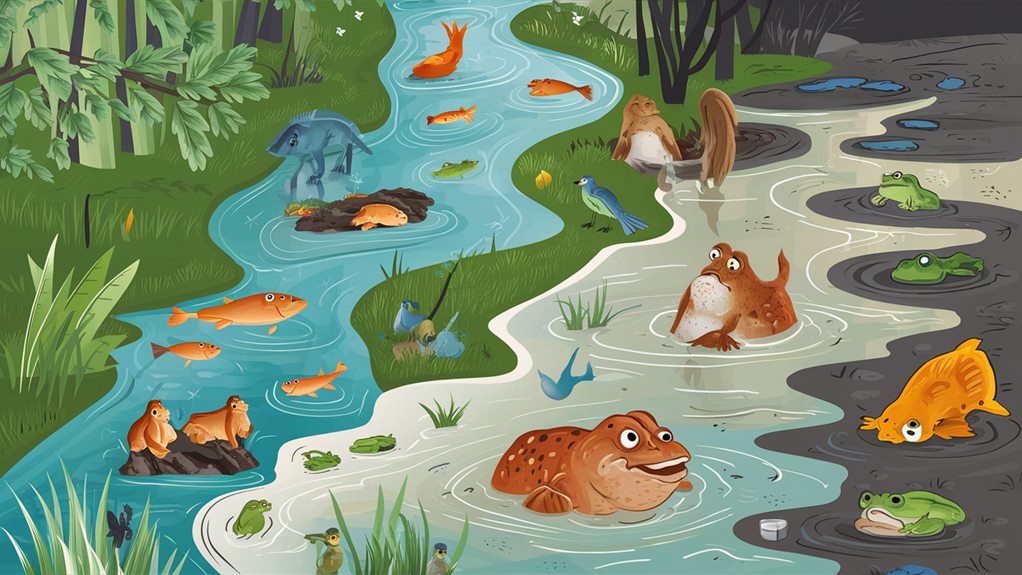
Beyond the impact on air quality, the chemicals found in traditional cleaning products pose significant risks to wildlife and biodiversity. As you work to keep your home spotless, it's important to understand how the runoff from these products affects the natural world around us. When these harsh chemicals make their way into waterways, they don't just disappear—they set off a chain of environmental consequences.
The effects of these chemicals are far-reaching, impacting not just individual species but entire ecosystems:
- Habitat Destruction: Chemical runoff can alter the physical environment of aquatic habitats, leading to loss of flora and fauna that are essential for ecological balance.
- Ecosystem Disruption: The introduction of unnatural substances can disrupt the nutrient cycles and natural chemical balances of ecosystems, affecting all organisms within them.
- Species Displacement: Native species often can't compete with altered conditions, leading to displacement by invasive species better suited to the new conditions.
- Population Decline: Toxic substances can reduce reproductive rates and increase mortality in wildlife populations, leading to a decline in species important for ecosystem functioning.
- Chemical Accumulation: Wildlife, particularly aquatic species, can accumulate harmful chemicals in their bodies, which can lead to long-term health issues and affect their survival and reproduction.
You're part of a community that impacts and is impacted by these natural systems. By making informed choices about the products you use, you can help mitigate these risks and contribute to the preservation of biodiversity and the well-being of wildlife populations. Your choices matter—not just for your home, but for the planet.
Human Health Concerns
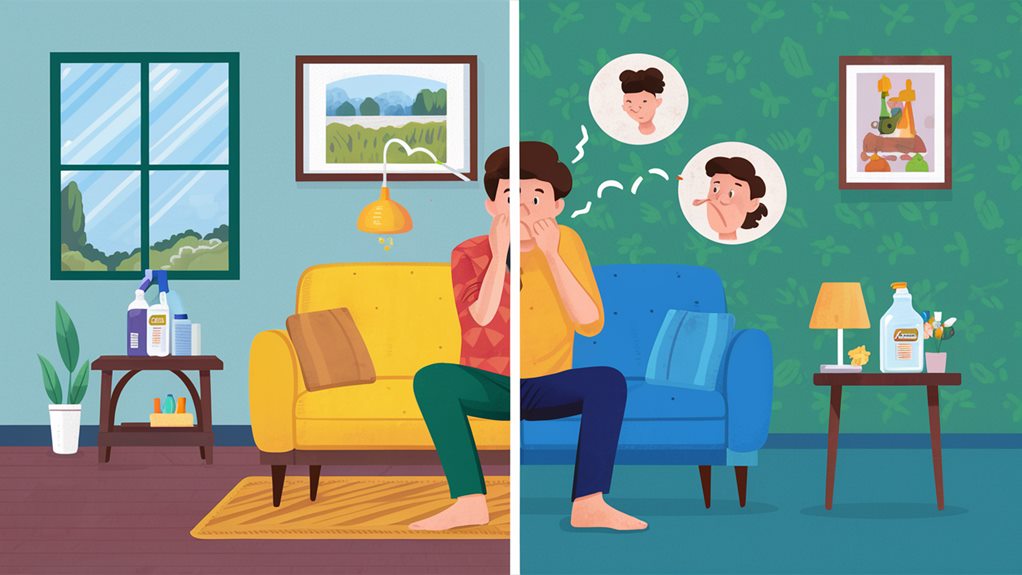
In addition to environmental risks, the chemicals in traditional cleaning products also pose serious health concerns for humans. When you use these products, you're often not just cleaning your home; you're also introducing a range of indoor pollutants. Many of these chemicals are volatile organic compounds (VOCs) that easily evaporate at room temperature, affecting indoor air quality. You might notice it as a strong smell after spraying a cleaner, but it's the unseen effects that are more concerning.
These VOCs and other chemicals in cleaners can contribute to chronic respiratory problems, allergic reactions, and headaches. Studies have shown that there's a significant increase in asthma cases associated with long-term exposure to air fresheners, cleaning sprays, and other scented products. It's essential to understand that these aren't just numbers; these could be real impacts on your or your loved ones' health.
Moreover, the risk of toxic exposure isn't just limited to the air. These substances can linger on surfaces, dishes, or clothes, leading to skin irritations or worse when they come into contact with your skin. Certain ingredients in cleaning products are endocrine disruptors, which can interfere with hormone systems and potentially lead to reproductive issues.
It's vital for you to take into account these factors when choosing cleaning products. Opting for products with fewer chemicals or those certified as environmentally friendly can reduce your exposure to these harmful compounds. By making informed choices, you contribute not only to your health but also to a healthier planet, fostering a sense of community and shared responsibility.
Packaging and Plastic Waste

You've likely noticed that most traditional cleaning products come in plastic containers, which greatly contributes to global plastic waste. Unfortunately, despite recycling efforts, a substantial portion of these plastics aren't recycled due to contamination or lack of facilities.
Exploring alternative packaging options, such as biodegradable materials or refill systems, could mitigate these environmental impacts.
Plastic Packaging Prevalence
Traditional cleaning products often come encased in single-use plastics, contributing substantially to global plastic waste. You're probably familiar with the bottles and wrappers that end up in your trash each week. Each of these contributes to a larger, global crisis of plastic waste impact, affecting marine life, disrupting ecosystems, and utilizing non-renewable resources for their production and disposal.
Here's a closer look at why this matters to you and what can be done:
- Volume: Millions of tons of plastic packaging are produced annually for cleaning products alone.
- Non-biodegradability: Most of these plastics don't degrade and can persist in the environment for centuries.
- Chemical leaching: Plastics can leach harmful chemicals into soil and water, which circles back to our own health risks.
- Resource intensive: Production of these plastics consumes vast amounts of energy and resources, which isn't sustainable.
- Alternatives exist: More companies are turning to sustainable packaging solutions, using materials like recycled plastics, bioplastics, and refillable containers.
Adopting sustainable packaging solutions not only reduces your environmental footprint but also aligns with a community that values responsible consumption. You're part of a global movement towards sustainability every time you choose a product with eco-friendly packaging.
Recycling Challenges
While sustainable packaging solutions are gaining momentum, recycling the vast amounts of existing plastic waste remains a significant obstacle. You're part of a community that recognizes the need for effective waste management. It's vital to understand that not all plastics used in cleaning product packaging are recycled equally. Some plastics are easier to process, while others end up in landfills or, worse, the oceans.
| Type of Plastic | Recyclability |
|---|---|
| PET (Polyethylene Terephthalate) | High |
| HDPE (High-Density Polyethylene) | Moderate |
| PVC (Polyvinyl Chloride) | Low |
| Other (Mixed Plastics) | Very Low |
The circular economy aims to keep resources in use for as long as possible, extracting the maximum value while in use, then recovering and regenerating products and materials at the end of their service life. However, the shift to this model faces challenges from existing waste management practices. You're in this together with others who care about our planet, working towards a system where every item is reused and nothing is wasted. It's about taking action now, in our homes and communities, to advocate for improvements in recycling technologies and systems that can handle the complexity of modern plastic waste.
Alternative Packaging Options
As the challenges of recycling traditional plastic packaging become more apparent, exploring alternative packaging options emerges as an important step. You're part of a community that values sustainability, and by choosing eco-friendly packaging, you contribute to a greener planet. Sustainable materials aren't just a trend; they're a necessity in reducing environmental impact.
Here are some innovative options you can look for:
- Biodegradable plastics: These materials break down much faster than traditional plastics, often incorporating plant-based elements.
- Recycled paper and cardboard: Using post-consumer materials lessens the demand for virgin resources and supports recycling industries.
- Edible packaging: Imagine using packaging that you can eat instead of throw away! This innovative approach is gaining traction in food-related products.
- Plant-based foams: Made from agricultural byproducts, these foams can replace synthetic cushioning in packaging, reducing dependency on petrochemicals.
- Glass and metal containers: Although heavier, they're 100% recyclable and can be reused multiple times, minimizing waste.
Energy Consumption in Production
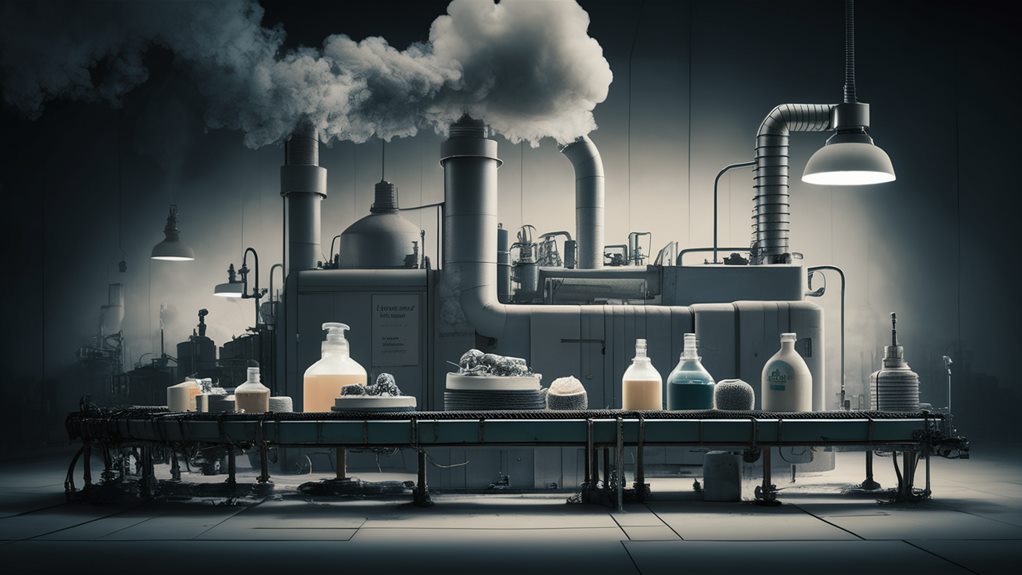
You should consider that the production of traditional cleaning products requires significant energy at every stage, starting with the extraction and processing of raw materials.
The efficiency of manufacturing processes varies widely, with some older facilities consuming far more energy than newer, more technologically advanced plants.
Additionally, the energy required for packaging and transporting these products to market adds a substantial amount to their overall carbon footprint.
Raw Material Sourcing
The sourcing of raw materials for traditional cleaning products demands a considerable amount of energy consumption during production. You're part of a community that values sustainability, and it's vital to understand how your choices impact the environment. The extraction and processing of these materials often require a large quantity of energy, primarily sourced from non-renewable resources, which contributes to environmental degradation.
To deepen your understanding, consider these aspects:
- Ethical sourcing: Ensuring the materials are sourced responsibly, respecting local communities and environments.
- Sustainable extraction: Methods that minimize environmental footprint are essential for reducing energy usage.
- Transportation energy: Raw materials often travel long distances from source to factory, consuming a significant amount of energy.
- Refinement processes: The energy-intensive steps to purify raw materials into usable forms.
- Dependency on fossil fuels: Many extraction processes rely heavily on oil and coal, which are major pollution sources.
Adopting practices centered around ethical sourcing and sustainable extraction can greatly lower the energy consumed, making a profound difference. This approach not only preserves natural resources but also fosters a sense of belonging in a community committed to environmental stewardship.
Manufacturing Process Efficiency
Shifting focus to the manufacturing process, it's important to evaluate the energy consumption in production. You'll see that energy efficiency isn't just a buzzword; it's a pivotal element in reducing the environmental footprint of traditional cleaning products.
During production, a substantial amount of energy is used in mixing, heating, and packaging processes. By optimizing these processes, manufacturers can significantly cut down energy use.
For example, implementing energy-efficient motors and adopting variable speed drives in conveyor belts can reduce electricity consumption markedly. It's not merely about using less energy but also about enhancing the production line's output per unit of energy consumed. This optimization contributes directly to lower overall emissions and operational costs.
Furthermore, waste reduction is another crucial factor. Efficient use of raw materials and recycling waste products in the production cycle minimizes the disposal of hazardous materials and the intensive energy use associated with waste management.
By integrating advanced filtration and reclamation systems, factories not only comply with environmental regulations but also reduce the volume of waste and the energy spent on waste processing.
As you can see, improving energy efficiency and waste reduction in the manufacturing process isn't just good for the planet; it's a smart business strategy that aligns with growing consumer demand for sustainable products.
Packaging and Transportation Energy
Consider the pivotal role that packaging and transportation play in the overall energy consumption of cleaning product production. When you choose a cleaning product off the shelf, you're not just buying the liquid or powder inside; you're also impacting the environment through the resources used for its packaging and the fuel burned to transport it to your local store. The packaging typically involves plastic and cardboard, which contribute significantly to packaging waste and add to the carbon footprint of the product.
The energy required to produce and transport these materials is substantial. Here's a deeper look:
- Production of packaging materials: Utilizing plastics and other materials in packaging demands a lot of energy, leading to higher carbon emissions.
- Transportation energy: The fuel used in shipping products worldwide notably increases their carbon footprint.
- Recyclability issues: Many packaging materials aren't recyclable, compounding waste management problems and energy use in disposal.
- Bulk and weight: Heavier and larger packaging requires more energy for transportation.
- Logistics inefficiency: Inefficient routing and partial load shipments can increase the number of trips needed, thereby boosting fuel consumption and emissions.
Biodegradability of Cleaning Agents

Evaluating the biodegradability of cleaning agents is vital in understanding their environmental footprint. When you choose a cleaning product, you're not just selecting a tool to keep your home or office clean; you're also making a decision that impacts the planet. Biodegradability testing provides essential data on how these substances decompose naturally in the environment. This testing examines whether a chemical will break down and, if so, how quickly and completely it does so, ensuring that harmful residues aren't left behind.
Understanding the results of these tests helps you make informed decisions. A product labeled as "biodegradable" suggests that it can break down naturally without leaving harmful byproducts, reducing its overall environmental impact. However, the rate and extent of biodegradability can vary significantly. Some substances degrade almost completely in a few weeks, while others might persist longer, slowly releasing pollutants.
Environmental impact assessments give a broader picture, evaluating not just the fate of the chemicals post-use but also their potential effects on aquatic life, soil health, and air quality. These assessments are essential because they help identify products that might seem harmless but actually pose long-term environmental risks.
You're part of a community that values sustainability and ecological responsibility. By choosing cleaning agents that are tested and proven to be environmentally friendly, you're contributing to a healthier planet. Remember, every small choice adds up to a noteworthy impact.
Let's make choices that allow us to live in harmony with our environment, supporting a sustainable future for all.
Regulatory Standards and Compliance
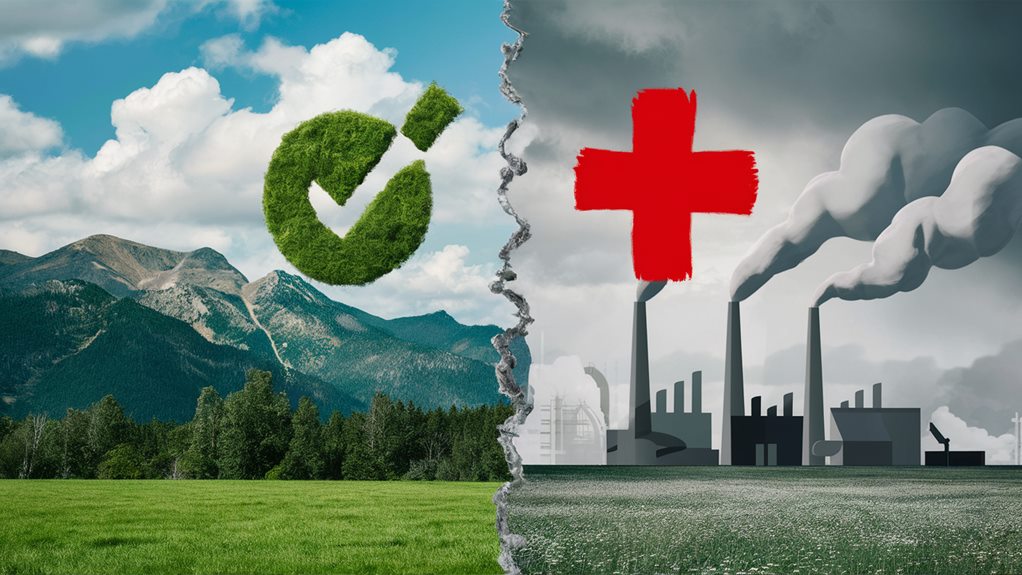
As you explore the environmental impact of traditional cleaning products, it's essential to understand the global regulatory variations that govern their use and disposal. Different countries have distinct standards and guidelines, which can complicate compliance for international manufacturers. These discrepancies often lead to significant challenges in ensuring that products meet all regional environmental protection requirements.
Global Regulatory Variations
Regulatory standards and compliance for cleaning products vary widely across the globe, reflecting diverse environmental priorities and health concerns of different regions. You'll find that navigating these differences is essential if you're involved in the manufacturing, distribution, or marketing of cleaning products internationally.
Understanding the landscape of global certification can greatly enhance your product's marketability by ensuring it meets the varied demands of different markets. Similarly, aiming for regulatory alignment might simplify legal processes and reduce costs associated with meeting multiple, diverse standards.
To give you a clearer picture, consider these key points:
- EU Ecolabel: Encourages products that are better for the environment, covering biodegradability and toxicity.
- EPA Safer Choice: Recognizes products in the U.S. that are safer for human health and the environment.
- Green Seal certification: Focuses on sustainability, health, and product performance.
- Ecocert: Offers organic certification for cleaning products, ensuring they meet strict natural and organic standards.
- ISO 14001: Supports environmental management systems, enhancing environmental performance.
Compliance Challenges
Traversing the diverse landscape of global regulatory standards is just the beginning; meeting these standards consistently poses substantial compliance challenges. As you dig deeper into the world of environmental regulations, you'll find that the hurdles aren't just high—they're often intricate and vary significantly across borders. This complexity can greatly impact your ability to maintain compliance, especially when your operations span multiple countries.
Understanding the specific regulatory hurdles and their environmental impact is essential. Each country you operate in might have its own set of rules regarding the chemical composition of cleaning products, their biodegradability, and their packaging. Here's a quick glance at how these standards can differ:
| Region | Key Compliance Issue | Sustainability Initiative |
|---|---|---|
| Europe | Strict chemical restrictions | High emphasis on recycling |
| USA | State-level variations | Focus on reducing VOC emissions |
| Asia | Diverse regulatory environment | Rapid adoption of green products |
To align with these varied regulations and actively contribute to sustainability initiatives, it's crucial to stay informed and agile. Compliance issues often require you to adjust your product formulations and rethink your supply chain strategies. Embracing these challenges not only helps protect the environment but also strengthens your belonging in a community committed to sustainability.
Alternatives to Traditional Products
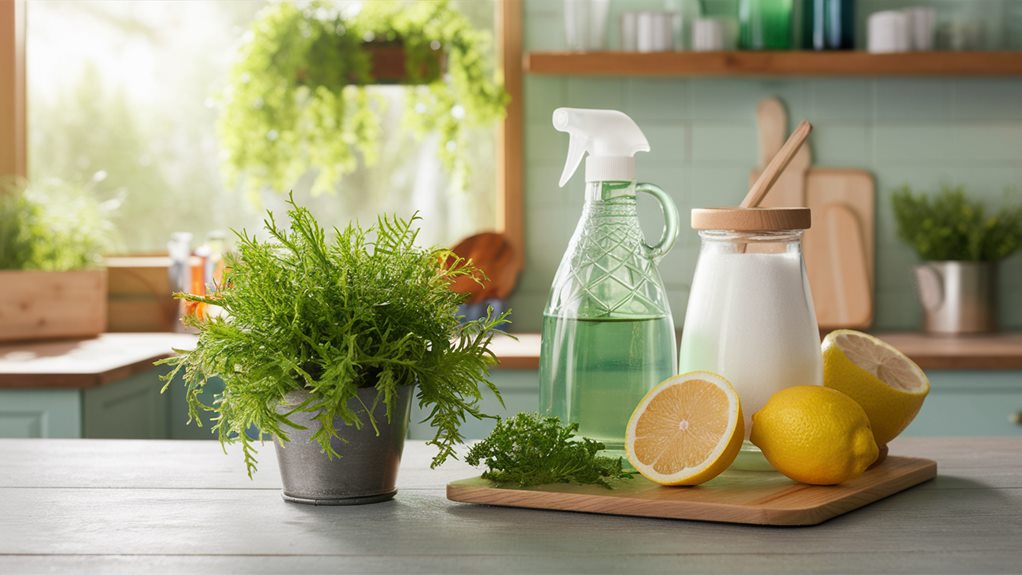
Switching from traditional cleaning products to eco-friendly alternatives can greatly reduce environmental harm. You're not only making a choice that benefits the planet but also creating a safer space for yourself and your family. The power of eco-friendly products lies in their simplicity and the mindful use of resources. By choosing alternatives that rely on natural ingredients, you're stepping away from harsh chemicals that pollute waterways and degrade soil quality.
Eco-friendly products often use ingredients that are biodegradable, non-toxic, and sourced sustainably, reducing your ecological footprint. Additionally, opting for DIY recipes can be both a fun and enlightening process, allowing you to understand exactly what goes into the products you use daily. This hands-on approach not only diminishes reliance on industrially produced goods but also fosters a deeper connection to your household's environmental impact.
Here are five compelling reasons to make the switch:
- Healthier Home Environment: Fewer airborne chemicals mean better indoor air quality.
- Safety: Natural ingredients reduce the risk of chemical burns and toxic exposure.
- Cost-Effective: Many eco-friendly solutions can be made from common household items.
- Waste Reduction: Reusable containers and minimal packaging help reduce landfill contribution.
- Community Impact: Supporting eco-friendly companies often means supporting sustainable practices globally.
As you integrate these alternatives, you'll find that your choices resonate with a larger community of people committed to making environmentally responsible decisions. This shared commitment not only enhances your sense of belonging but actively contributes to a collective effort for a healthier planet.
Frequently Asked Questions
How Do Traditional Cleaners Influence Global Warming?
Traditional cleaners often release harmful chemicals that contribute to global warming by increasing carbon emissions and accelerating ozone depletion. When you use these products, you're adding to the release of potent greenhouse gases. These gases trap heat in the atmosphere, boosting global temperatures and disrupting climate patterns.
Are There Tax Incentives for Using Eco-Friendly Cleaning Products?
Why wouldn't you switch when there are benefits? Many countries offer tax incentives for using eco-friendly cleaning products. These incentives aim to reduce environmental harm by encouraging businesses and consumers to choose greener options.
How Do Cleaning Products Affect Indoor Plants?
You mightn't realize it, but the cleaning products you use can greatly impact your indoor plants. When you choose cleaners with harsh chemicals, your plants suffer from chemical exposure, potentially compromising their health. Opt for gentler, eco-friendly options to make sure your green friends thrive.
Can Old Cleaning Products Be Recycled?
Yes, you can recycle old cleaning products, but it's a bit like finding your way through a maze.
You'll need to investigate local recycling options and follow specific sustainability measures. Confirm containers are empty and take note of the chemical composition of the contents; not all facilities process all types.
By participating in community recycling programs, you'll not only dispose of waste responsibly but also contribute to a collaborative effort in advancing environmental health.
What Are the Economic Impacts of Producing Traditional Cleaners?
When you explore the economic impacts of producing traditional cleaners, you're examining both production costs and environmental impact. These costs often mirror the wider supply chain and sustainability concerns.
For example, inefficiencies and resource depletion can increase prices, impacting both manufacturers and consumers. Additionally, the dependence on non-renewable resources strains ecosystems, indirectly affecting economic stability by endangering future resource availability.
It's important to take these factors into account in your purchasing decisions.
Conclusion
As you navigate the forest of modern life, consider the hidden impact of your choices. Traditional cleaning products, akin to invasive species, subtly degrade the sanctuary of our environment—from polluting waters that fish call home to tainting the air we all breathe. It's crucial to explore and embrace greener alternatives, just as a gardener nurtures native flora. By choosing products that are kind to Earth, you help restore the balance, ensuring a healthier ecosystem for all creatures, including ourselves.

